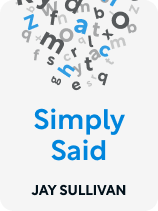

This article is an excerpt from the Shortform book guide to "Simply Said" by Jay Sullivan. Shortform has the world's best summaries and analyses of books you should be reading.
Like this article? Sign up for a free trial here .
What is Jay Sullivan’s Simply Said about? What is the key message to take away from the book?
In his book Simply Said, communication expert Jay Sullivan provides a blueprint for effective business communication. Top-notch communication skills are essential to success in any professional field—after all, you can only get clients, colleagues, and audiences to buy into your ideas if you’re able to communicate them clearly.
Here’s a brief overview of Jay Sullivan’s book Simply Said: Communicating Better at Work and Beyond.
Simply Said: Communicating Better at Work and Beyond
In his book Simply Said, Jay Sullivan argues that you can deliver a clear and compelling message by focusing on what others hope to get from the exchange and communicating in a way that serves them. Sullivan’s key premise is that great communication comes from understanding and connecting with other people instead of focusing on ourselves. He explains that we tend to communicate from our own perspective, without considering other people’s points of view. This then leads to miscommunication.
(Shortform note: People also may miscommunicate because they approach an issue from different levels. In Principles, Ray Dalio writes that every person has both a rational and an emotional level, and two people who are talking to each other may be unaware of which level is in control. This may lead to a breakdown in communication. For example, one person may operate on the rational level and give you corrective feedback to help you improve. But if you hear the feedback from an emotional level, you may not realize the other person has the best intentions—instead, you may feel hurt at being criticized and lash out at them.)
Sullivan argues that you can deliver a clear, compelling message by starting from the perspective of others, homing in on what they hope to get from the exchange, and communicating in a way that’s easy for them to understand.
(Shortform note: In an interview, Sullivan elaborates on why communicating effectively is important for professional success. He argues that the smartest person in the room isn’t necessarily the most successful—you can have the best ideas, but if you can’t persuade others to get on board with them, then you won’t be successful. Excellent communication skills are what sets strong performers apart and takes them to the next level.)
Sullivan is the former managing partner at Exec|Comm, LLC, a firm that provides communication skills training to professionals worldwide. It was his work here, and specifically their philosophy of focusing on others, that inspired him to write Simply Said. Published in 2016, Simply Said has received mostly positive reviews, with readers praising Sullivan’s straightforward, practical advice. Critical readers note that the book can be repetitive (Sullivan frequently reiterates the importance of focusing on others) and that the author touches on a lot of topics without discussing them comprehensively.
In this guide, we’ve reorganized the book into three parts:
- Part 1 covers Sullivan’s general tips for making presentations that grab—and keep—the audience’s attention.
- Part 2 discusses his tips for effective oral communication; we’ve also included how to apply these ideas to different situations.
- Part 3 focuses on improving your written communication in documents and emails.
In each part, we’ve centered the tips around Sullivan’s main theme of focusing on others. We’ll also explore Sullivan’s recommendations in depth, provide insights from other communication experts, and suggest how to adapt communication to other cultures.
Part 1: How to Prepare a Clear and Engaging Message
Whether you’re talking one-on-one with a client or presenting to an audience of hundreds, your goal is to make it easy for the other party to understand your point. In this section, we’ll discuss Sullivan’s tips for delivering a strong, memorable message that won’t be open to misinterpretation.
Tip #1: Know What You Want to Say
Sullivan recommends that before you speak, you determine the one main idea that you want your audience to take away from your meeting or presentation. He writes that many speakers often don’t know what their main point is, which is problematic—if you’re confused about your main point, then the audience is likely to be confused too. So clarify your main point before you flesh out your presentation to ensure that your audience will receive the message you intend. For example, if you’re presenting sales data from two quarters, decide ahead of time what you want your team to take away—should they be celebrating an improvement, reflecting on poor performance, or brainstorming for the future?
(Shortform note: To know if you’ve developed a clear core message, check for three signs: 1) It captures what your presentation is about, 2) your audience can easily repeat it, and 3) all the information you present is connected to it.)
Sullivan advises that you communicate this key message in a way that’s short and simple: State it in just one sentence with fewer than 10 words. Save secondary details—like the why’s and how’s—for succeeding sentences. Only use industry jargon with people in your industry, and avoid big words and corporate-speak. For example, instead of saying, “We must all determine and leverage our core competencies to administrate exceptional synergy and increase efficiency,” state it simply as, “Let’s pool our strengths to work together more efficiently.”
(Shortform note: Sullivan cautions against flexing your vocabulary in an attempt to sound smart. In an interview, he says that trying to sound smart only makes you sound full of yourself. If you want to come off as smart, just make it easier for the other person to understand you.)
Tip #2: Create an Organized Presentation
Once you know what you want to say, it’s time to work on how you’re going to present it to your audience. Sullivan says that effective presentations follow a standard format for communicating information: Tell them what you’re going to tell them, tell them, then tell them what you just told them. (Shortform note: This format allegedly originated from Aristotle, the Greek master of rhetoric; 2,500 years later, it’s still being taught.)
Sullivan’s version of this classic structure comprises six parts:
1) Have a strong opener. Immediately grab your audience’s attention with a problem, a fact, a statistic, a rhetorical question, or a powerful image. For example, if you’re trying to convince management to allow remote work, you can begin your presentation with how much money your department loses as a result of workers’ commutes. This would make a strong opener because it piques the audience’s interest—they would want to know what the relationship is between commuting and the bottom line.
(Shortform note: It’s important to start strong because you only have limited time to set the tone for your presentation—in TED Talks, Chris Anderson writes that you have only about 60 seconds to capture your audience’s attention once you start talking. This is the window of time when the average audience is still listening closely before they start to get distracted. Anderson also says that the first minute of your speech sets the tone for the rest of it, which makes it extra important to get right.)
2) Deliver your conclusion first. Instead of saving your conclusion for last, reveal your recommendation up front. Sullivan says that this keeps the audience from getting impatient and gives them the proper context, making it easier for them to follow the rest of the presentation. Otherwise, they’ll spend the whole time trying to figure out where you’re leading them.
Continuing the previous example, your recommendation can be, “We need to switch to a remote working setup.” (Remember: one sentence with fewer than 10 words.) After you clearly state your recommendation, you can then go into the details: “We will need to establish a dedicated communication channel, set common availability hours, and schedule regular check-ins to ensure that work stays on track.”
(Shortform note: While Sullivan writes that stating your conclusion in the beginning gives your audience a big-picture view of your presentation, saving your conclusion for last can be useful for building suspense. However, this may only be effective in a few scenarios—such as keynote speeches—and in the hands of more seasoned speakers.)
3) Answer: “What’s in it for them?” Stick to Sullivan’s premise of focusing on other people by identifying three to five benefits of your recommendation for your audience. Sullivan writes that the most effective benefits are geared toward the universal motivators of time, feelings, and money. List all these benefits in one slide. For example: “If we switch to a remote working setup, we’ll be able to: 1) increase productivity, 2) allow for more flexible hours, and 3) save on office space expenses.”
(Shortform note: The type of benefits you present may vary depending on the type of thinkers that make up your audience. In The Culture Map, Erin Meyer explains that analytical thinkers—typically Westerners—prefer to know details that directly affect them, while dialectical thinkers—typically Asians—care more about how things impact a broader unit like the company or even the country.)
4) Back up the benefits with data. If you’re using visuals, after stating the benefits on one slide, use succeeding slides to prove that these benefits are real. Sullivan recommends devoting one slide for every benefit mentioned and using statistics, testimonials, or anecdotes to convince your audience that the benefits are evidence-based.
For example: “Increase productivity: Our workers commute an average of 90 hours per year—the equivalent of two-and-a-half working weeks. This results in lost productivity: Since workers have to get up early and get home late, they suffer from disrupted sleep, reduced work-life balance, and more sick days. If we shift to remote work, we may initially experience reduced productivity; however, research shows that after the adjustment period, productivity can increase by as much as 47%.”
(Shortform note: While Sullivan recommends appealing to the audience’s reason with data, others argue that it’s more effective to appeal to their emotion. In Thank You for Arguing, Jay Heinrichs writes that emotions are much stronger than reason and are thus better at motivating people to act. To appeal to an audience’s emotions, Heinrichs recommends telling vivid stories, describing what you felt during an experience without getting overly emotional yourself.)
5) Recap. Following the traditional format, summarize what you just discussed: Reiterate your recommendation and briefly repeat the benefits. (Shortform note: Research supports Sullivan’s advice to restate your recommendation at the end so that people will get your message. This is because of the audience attention curve: While the average audience member may pay close attention to the beginning and end of a presentation, their attention drops by as much as 90% in the middle of it.)
6) Outline action steps. Clearly state the next steps and who’s responsible for them, says Sullivan. This ensures accountability.
For example: “If you approve this recommendation by the end of the month, we will start the transition to remote work by Week 1 of next month. Jeff will coordinate with Maya from IT to set up our cloud-sharing facility and communication channel. In Week 2, I will outline the team’s deliverables and deadlines for the next two months and plot our regular check-in times. In Week 3, Team A will serve as our pilot group and begin working from home. In Week 4, Team A and I will submit a report about what worked and what needs to be improved.”
(Shortform note: Aside from outlining action steps, Sullivan doesn’t give any other recommendation for ending your presentation. In Ted Talks, Chris Anderson says that a great talk can be ruined by a bad closing, so end it on a high note by inspiring your audience with a vision or leaving them with a poetic statement or an eloquent phrase.)
Put Together Your Slide Presentation
You don’t have to work on your presentation in the order listed above. In fact, Sullivan says it’s often easier to start with your main message and benefits before working on your opener. Once you’ve made your notes, you can create a slide presentation (also known as a slide deck) on a program like PowerPoint or Google Slides, keeping the following tips in mind:
- Make it easy for your audience to digest the information. Use short bullet points instead of sentences, with a maximum of six words per bullet and six bullets per slide. Don’t include bullets that you won’t discuss.
- If you’re adding bullet points to a slide with a graph or chart, make sure the bullets enhance—rather than merely repeat—the visual information.
- Don’t use sounds or animation that may be distracting for your audience.
Present From Your Slide Deck
Your job doesn’t end with putting together a solid slide deck—you still have to talk about your message. Your slides merely serve as a tool to help the audience more easily understand what you have to say. To improve your delivery when presenting with a slideshow, Sullivan recommends that you:
1) Make the audience feel like they have your full attention. Stand to the left of the screen from the audience’s point of view, making sure that your body is oriented toward them.
2) Stand in one place. While moving around the room has its advantages, it distracts your audience and divides their attention between you and the screen.
3) Look at your slide, turn to your audience to repeat what it says, then add more details. While other communication experts say that the audience doesn’t like it when a speaker reads off their slides, Sullivan argues that this is only true when the speaker doesn’t add more information. He says reading what’s on your slides helps your audience absorb your message better because both their sight and hearing are focused on the same information. In other words, adding more information is important after reading the exact text on your slides to help your audience process it.
We’ll cover more tips for improving your oral communication skills and presenting effectively in Part 2.
Part 2: How to Improve Your Oral Communication Skills
Now that you know how to prepare a clear and engaging message, it’s time to work on delivering that message with maximum effectiveness. Sullivan says that the main principle when it comes to oral communication is to use the same techniques whether you’re talking with one person or a roomful of people—maintain the same level of confidence, attention, and engagement. In this section, we’ll first discuss his general tips for improving oral communication, then we’ll go into his tips for applying these skills to specific business situations.
Tip #1: Mind Your Voice
Sullivan advises paying attention to the speed, volume, and tone of your voice:
Speed: You’ll more likely need to slow your pace rather than speed it up—most people talk fast out of nervousness. (Sullivan does add that talking fast on purpose can imply a sense of urgency.) Also incorporate pauses to give your audience time to process what you just said. (Shortform note: What’s so bad about talking fast? Not only does it make you appear less confident and unorganized, it also makes your audience work harder to understand you—which goes against Sullivan’s advice to focus on their needs. Work on your pace by recording yourself as you practice your presentation. From there, you can gauge exactly how fast you’re talking and make adjustments. A good rate to aim for is 150-160 words per minute.)
Volume: When speaking without a microphone, Sullivan recommends projecting your voice enough to reach the person farthest away from you. Deliberately varying your volume can keep people more engaged. Saying something loudly can emphasize a point; counterintuitively, lowering your voice on occasion can encourage them to lean in and listen more intently. (Shortform note: Remember that projecting your voice is different from yelling—yelling uses your vocal cords, while projecting uses your diaphragm, or the muscle at the base of your chest. To practice using your diaphragm, try this exercise: Take a big breath in, feeling your abdomen expand, then force all the air out with a “ha.” You should feel your diaphragm contract.)
Tone: Inject energy and positivity into your tone by delivering your message with a smile. Avoid sounding lifeless, which tends to happen when you read your notes in a monotone voice. However, Sullivan cautions that while varying your tone, you should avoid “upspeak”—using a rising inflection at the end of a declarative sentence, making it sound like a question. This type of tone makes you sound tentative. (Shortform note: Sullivan says you should avoid upspeak, which is often derided as an undesirable practice, but others argue that it has a necessary function: Contrary to the belief that it makes you sound tentative, it may actually encourage other people to listen actively and discourage them from interrupting.)
Tip #2: Use Eye Contact to Connect With Your Audience
Every time you say something, make eye contact with members of the audience. However, Sullivan says your eyes shouldn’t constantly dart around the room. The proper way to make eye contact when presenting to a group is to look at one person for as long as it takes to complete a sentence. Then, move onto another person. Give key decision-makers more attention, but don’t ignore all the other people in the room—you want to make your whole audience feel like you’re connected to them.
(Shortform note: Making eye contact with your audience, as Sullivan recommends, not only forges a connection with them but also clues you in on how they’re receiving your message. In 12 Rules for Life, Jordan Peterson says you can use eye contact to gauge the audience’s reaction to what you’re saying—whether it’s confusion or acceptance—and then modify your presentation accordingly.)
In a one-on-one conversation, Sullivan advises gauging the other person’s comfort level with eye contact; if they seem uncomfortable holding your gaze, drop your eyes from time to time while you’re not talking, perhaps to jot down a note. (Shortform note: While Sullivan isn’t specific, some communication experts recommend maintaining eye contact 50% of the time while speaking and 70% while listening.)
Tip #3: Communicate Openness and Confidence With Your Body
The author says that your body language should be open and neutral, whether you choose to stand or sit:
Standing: Stand with your feet directly under your hips with your weight evenly distributed and your hands apart—this keeps you from fidgeting or crossing your arms, which makes you look closed off. It also leaves you free to use hand gestures to emphasize your points.
Seated at a table: Sit up straight and stay still (no swiveling), keeping your forearms on the table with your hands on either side of your notes.
Sullivan adds that your facial expression should convey that you want to be there; even if you’re delivering bad news and deem it inappropriate to smile, wear a sincere expression that shows you’re ready and willing to provide support.
Tip #4: Listen Well
Oral communication skills aren’t just about talking—listening is equally important, because it enables you to understand the other person and gain their trust and respect. Listening is an important element of Sullivan’s core message of focusing on the other person.
He recommends you treat a conversation not as an opportunity to grandstand but as a chance to learn more about the other person’s needs. For example, if you’re in a client meeting, keep asking questions until you uncover useful information.
The type of questions you ask will depend on your objective:
- Ask closed questions if you need specific information from the other person—for example, “Can you complete this by 4 p.m. on Thursday?”
- Ask open-ended questions if you want a deeper, nuanced response—for example, “Why do you think that is?” It’s also a good opportunity to show the other person that you’re there for them by asking questions like “What can I do to help?”
(Shortform note: Keep in mind that you may have to read between the lines when it comes to their answers—people tend to respond differently based on their status or level of power in relation to yours. Culture also plays a part: For example, Asian cultures tend to be disagreement-avoidant because they believe that disagreeing can damage relationships.)
If you’re unsure about what the other person is trying to say, clarify using three steps:
- Step 1: Start with an introductory phrase (“If I understood it correctly…”).
- Step 2: Restate what they said. You can use the exact words they used or, if they didn’t say it clearly, rephrase it to reflect their message.
- Step 3: End with a question to confirm your understanding (“Did I get that right?”).
Tip #5: Answer Questions With Ease
When fielding questions from your audience, Sullivan warns against latching onto specific words and thinking of an answer before you hear the whole question. Once you know exactly what they’re asking, restate the question or comment on what they said (“That’s a great point”) to buy time to come up with a response. Answer briefly without digressing, then move on to the next question.
(Shortform note: If you’re nervous about fielding questions, you can ease your anxiety by being prepared and considering what you would ask if you were in the audience’s place. Questions usually revolve around three themes: 1) the downside for the audience, 2) how your message links to their other concerns, and 3) what your message means going forward.)
If the question is emotional rather than rational, Sullivan recommends the following strategy: First, acknowledge what the other person is feeling (“I understand your concerns”). Second, empathize with what they’re feeling (“I also had the same worries”). Lastly, answer briefly, perhaps offering other options.
(Shortform note: Sullivan recommends showing empathy when you answer an emotional question. You can do this by tapping into skills that create empathy that Brené Brown outlines in Dare to Lead: 1) Take the other person’s perspective (which echoes Sullivan’s main premise), 2) be nonjudgmental, 3) understand how the other person feels and be able to articulate this understanding, and 4) manage your own emotions so that you’re neither suppressing nor exaggerating them.)
Communicating in Specific Scenarios
In this section, we’ll give Sullivan’s tips for communicating effectively in some common business situations. The main principles to remember are to focus on the other person’s needs and to approach every interaction with a positive attitude.
How to delegate work: When assigning work to other people, Sullivan outlines six steps:
- Give proper context by clarifying how their work can help the company and the client. Sullivan says that this encourages people to do their best.
- Clearly state the task.
- Explain who else is involved and what each of their responsibilities are. This way, they can go to the correct colleague for assistance as needed and also see that they’re not working in a silo.
- Tell them why you chose them for this task and how this would benefit them (if applicable).
- Define expectations by telling them what to do first and the final output you expect and by when.
- Ask them to recap what you just discussed to make sure you’re on the same page.
(Shortform note: Delegation-related communication doesn’t end after you hand out assignments, but Sullivan doesn’t go into detail about what comes next. In High Output Management, Andrew Grove writes that you’re still responsible for the task even if you’re not doing it yourself, so be sure to monitor the person you’ve delegated to. He recommends 1) checking tasks in the early stages so that people won’t waste time overhauling the final output and 2) spot-checking samples of work rather than inspecting everything.)
How to deliver feedback: Get the person’s permission before diving in. For example, you can ask, “Do you have 10 minutes this afternoon?” As in your presentations, begin by communicating your “conclusion”—right off the bat, let the other person know if their work was satisfactory or not so that they can get into the right frame of mind to receive the rest of your message. Be specific about what they did well and their points for improvement, citing concrete examples. In the case of corrective feedback, work with them to determine what they can do to improve, then let them take the lead in figuring out their next steps.
This goes both ways: Ask for feedback from the people around you to show that you want to keep growing.
(Shortform note: Keep in mind that different cultures have varying degrees of tolerance for negative feedback, and you should proceed accordingly. In The Culture Map, Erin Meyer explains that there are two extremes on the feedback spectrum: direct negative feedback and indirect negative feedback. In cultures that value direct negative feedback (such as in Germany), people state negative feedback clearly and explicitly and may do so in public. On the other hand, cultures that are more indirect (such as in Indonesia) take a subtler approach, delivering the message with positive affirmations and verbal weakeners like “slightly” or “in my opinion.” They also tend to give feedback in private.)
How to introduce a speaker: If you’ve been tasked to introduce a speaker, your job is to connect the personality to the audience’s needs, asserts Sullivan. Select a couple of highlights from their bio, and focus on discussing those. Keep your introduction to a maximum of five minutes. (Shortform note: Additionally, keep in mind that an effective introduction meets three goals: 1) focusing the audience’s attention on the speaker, 2) showing that you vouch for the speaker’s credibility, and 3) getting the audience curious about what the speaker has to say.)
How to give a toast: The main thing to remember is that it’s about the other person, not about you. Sullivan says to make it personal, positive, and brief. (Shortform note: If you don’t know how to begin, think about why everyone is gathered together, and start with that (“We’re here to celebrate Susan as she starts an exciting new chapter as head of sales.”). Even if what you come up with doesn’t sound original, it does the work of bringing the audience together and setting the tone.)
Part 3: How to Write Effective Documents and Emails
In addition to oral communication, written communication is also a necessary part of any professional field. In this section, we’ll cover how to write documents and emails that people will actually read. In keeping with his main theme of focusing on the other person, Sullivan advises writing with the reader in mind—consider why they’re reading your message and what you want them to do with it, and make it easy for them to understand what you’re saying. He has the following specific tips:
Tip #1: Keep It Short
Sullivan says people are more likely to read a short document than a long one. As a general rule, keep each sentence shorter than 17 words long, but vary your lengths to keep the rhythm interesting. (Shortform note: Other experts recommend an average of 25 words per sentence and add that if you can’t accurately capture your idea within 25 words, don’t be afraid of going longer—clarity is more important than length.)
Also keep paragraphs short—going beyond a quarter of a page for a paragraph can overwhelm your reader. Sullivan says you can trim the fat by:
Eliminating unnecessary words and shortening phrases. For example, replace “the reason for,” with “because” and “despite the fact that” with “although.” (Shortform note: Other words that tend to lengthen text include redundant pairs such as “each and every”; unnecessary qualifiers such as “basically,” “actually,” and “extremely”; and ideas expressed in the negative such as “not accept” instead of “reject” and “not allow” instead of “deny.”)
Using strong verbs in place of weak nouns. Let your verbs do the heavy lifting; read each sentence to see if you’ve clearly expressed the key action in each sentence. Edit out nouns that end in –tion, -ment, –ance, and -ing, and replace them with action words. For example, instead of saying, “This document will help you in the development, implementation, and evaluation of the new system,” say, “This document will help you develop, implement, and evaluate the new system.”
(Shortform note: Strong verbs are generally preferable to nouns because they sound more authoritative and convincing. However, Sullivan doesn’t identify which verbs are considered strong and which ones are weak. Experts say that verbs like “did,” “was,” and “said” don’t make as much of an impact as more descriptive verbs such as “develop,” “assert,” and “define.”)
Tip #2: Use the Proper Voice
You can make your message stronger or soften the blow of bad news with the right voice. Review every sentence to check that you’ve used the appropriate voice:
Active voice: In this case, the actor comes before the verb. (For example: Our department will gather all the data.) It’s generally the preferable form because it’s simpler, stronger, and clearly states accountability.
Passive voice: In this case, the actor is relegated to the end of the sentence or isn’t there at all. Sullivan writes that this voice is often vague and doesn’t have as much of an impact. For example, when you write, “Updates will be emailed weekly,” it’s unclear who will be doing the updating. Sullivan recommends that you use this voice purposefully—for example, when avoiding accountability to soften a message (“Your proposal was rejected”).
(Shortform note: Sullivan’s note about preferring the strong active voice falls within the larger debate about the weakness of the passive voice and the advice to avoid it. Some writers argue that a passive sentence construction can still be strong; for example, Winston Churchill—one of the greatest speakers in history—frequently used passive verbs to great effect. When it comes to communication, the real goal is to simply write clearly and “let the verbs fall where they may.”)
Tip #3: Follow a Format
Sullivan says that documents generally fall into one of two purposes: persuasive or informative. Each one follows a standard format, which saves you a lot of time and effort—you don’t have to reinvent the wheel every time you write a document. Instead, just use a tried-and-tested format, changing the details as needed.
1) Persuasive: This type of writing is meant to convince the reader to take an action or think a certain way. When writing persuasively, Sullivan recommends you:
- Start with the present: Deliver your main message in the first sentence.
- Detail the past: If the reader needs more information, include a paragraph about the history and context of the issue.
- Look to the future: Discuss the benefits of taking action. Conclude with next steps, clearly stating the deadline and the persons involved.
(Shortform note: Sullivan doesn’t cover how to persuade your audience based on their patterns of thinking. In The Culture Map, Erin Meyer offers tips for persuading your audience based on whether they practice applications-first thinking (considering practical solutions to a problem) or principles-first thinking (looking at the reasons behind a problem). She writes that you’ll have better luck persuading applications-first thinkers by sending shorter, concise messages of no more than 125 words. On the other hand, principles-first thinkers will respond more to messages that focus on theory.)
2) Informative: This type of writing is meant to brief the reader about a topic or issue. When writing to inform, Sullivan recommends you follow the presentation format that we discussed in Part 1: Tell them what you’re going to tell them, tell them, then tell them what you just told them.
- Tell them what you’re going to tell them: State the issue, and give a brief background.
- Tell them: Enumerate specific matters that you’ll address in the document (Matter 1, Matter 2, Matter 3, and so on). Then, explain each matter one by one.
- Tell them what you just told them: Summarize what you just said, then clarify the next steps.
(Shortform note: Some experts argue that the triple “tell them” approach may not be effective in every scenario, saying that there can be too much of a good thing—excessively signposting can make your audience feel patronized and impatient. While this generally applies to slides, it helps to review your long documents to make sure that you’re not falling into the trap of perpetual announcement: Check that you don’t keep telling them what’s about to come in the next section.)
Writing Emails
Sullivan writes that there are over 100 billion emails sent every day. To keep yours from ending up in the “unread” pile, he offers the following tips for crafting stronger emails:
Avoid vague subject lines. Give enough context for what the email is about. For example, instead of “quick question,” say “question about the Project XYZ timeline.” If your email thread has morphed into another topic after a lengthy exchange, update the subject line to reflect the current discussion. (Shortform note: As Sullivan says, billions of emails are sent every day. Getting the subject line right can make your email stand out in an overflowing inbox. Aside from being specific, experts recommend limiting it to six to eight words and putting the most important words in the beginning.)
Know who to name. If you’re writing to three people or fewer, name everyone in your opening greeting. Otherwise, opt for something more general, such as “Sales Team.” (Shortform note: Additionally, don’t shorten people’s names (for example, from Gregory to Greg) unless you’re sure that they prefer the nickname.)
Make it easy for the other person. Adhere to Sullivan’s golden rule of focusing on your reader: Make it easy for them by clearly stating requests and deadlines and responding promptly—even if it’s just to acknowledge the email and say you’ll get back to them later. Use polite language, and say “please” and “thank you” to minimize the chances that your email will be misinterpreted.

———End of Preview———
Like what you just read? Read the rest of the world's best book summary and analysis of Jay Sullivan's "Simply Said" at Shortform .
Here's what you'll find in our full Simply Said summary :
- A blueprint for effective business communication
- How to create and deliver memorable presentations
- How to write documents and emails that people will actually read






